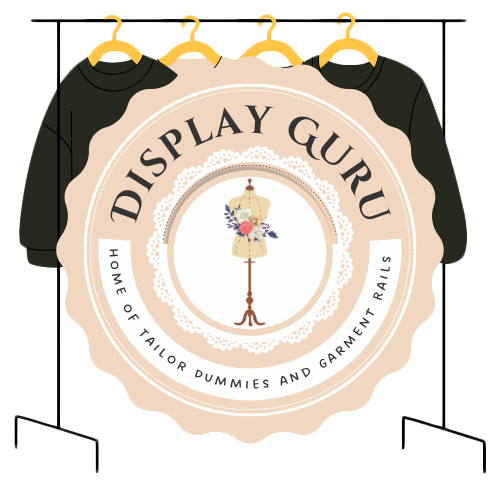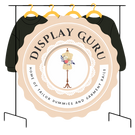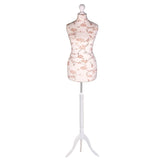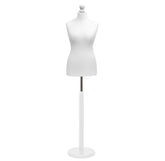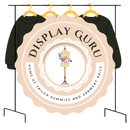dressmakers form adjustable: Your Guide to Perfect Fit
Ever tried to pin a hem on yourself? Or tried to get the back of a garment to sit just right without a patient friend to help? That’s where an adjustable dressmakers form comes in, and it's so much more than just a fancy mannequin.
Your Silent Partner for the Perfect Fit
Think of an adjustable dress form as your very own sewing assistant. It’s a stand-in body that perfectly matches any set of measurements you need, patiently holding still while you drape, pin, and perfect every seam. It’s less of a static dummy and more like a sculptor's armature for fabric, giving you the three-dimensional foundation needed to build truly custom-fit clothing.
This isn’t just a tool for display; it’s a dynamic and responsive canvas for your work.
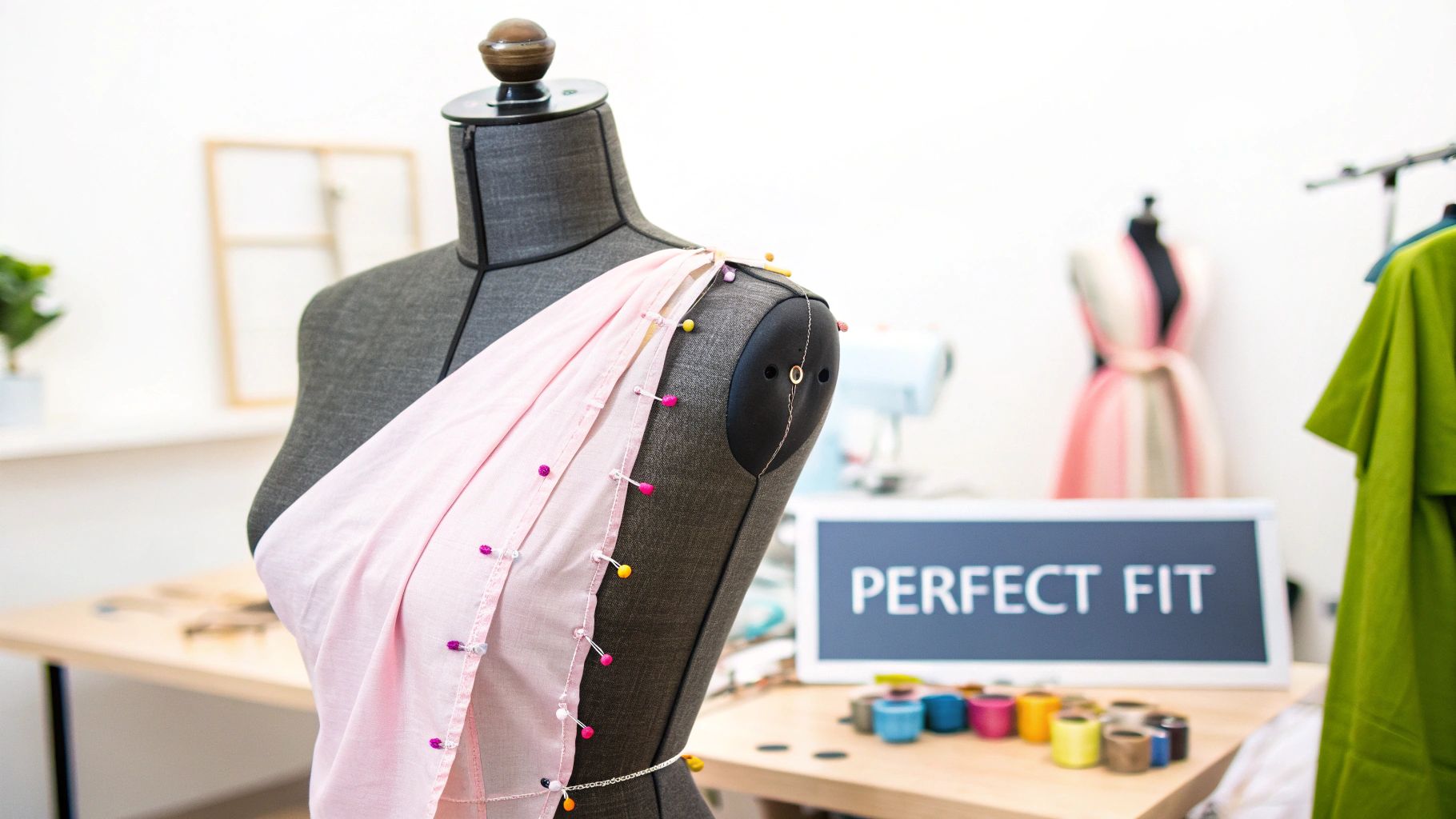
The real magic is in the dials and keys. With a few simple turns, you can precisely adjust critical areas like the bust, waist, and hips to create a true body double. This simple mechanism transforms the often frustrating guesswork of fitting into a streamlined, accurate, and genuinely enjoyable part of the creative process. Suddenly, professional-level fitting isn't just for couture houses—it's right there in your sewing room.
Why an Adjustable Form is a Game-Changer
For anyone who takes dressmaking seriously, getting a flawless fit is the pinnacle of success. An adjustable form makes this achievable by giving you a reliable reference point from start to finish. It takes the guesswork out of working with flat patterns, letting you see exactly how a fabric will hang and drape on a real body.
- Precision and Accuracy: You can dial in exact measurements, ensuring your finished garment fits the intended person like a glove.
- Efficient Alterations: Pin and tweak existing clothes directly on the form. This lets you see the effect of your changes in real-time, saving countless fitting sessions.
- Creative Freedom: Draping fabric directly onto the form can unlock incredible design ideas, allowing you to create patterns organically and experiment with new silhouettes.
- Versatility for Multiple Projects: A single form can be adjusted for different people and sizes, making it a smart, cost-effective investment if you sew for family, friends, or clients.
The real power of an adjustable dressmakers form is its ability to translate a flat, two-dimensional pattern into a three-dimensional reality. It reveals potential fitting issues long before you've sewn the final stitch.
Bridging the Gap Between Concept and Creation
This is where your sewing projects go from looking homemade to impeccably made. Whether you're tailoring a bespoke jacket, designing an elaborate gown, or simply altering a shop-bought dress, the adjustable form is the bridge between your vision and the perfectly finished piece.
While a physical dress form is an invaluable tool for hands-on work, it's also interesting to explore the latest in virtual dressing room technology, which aims to achieve similar fitting precision in a digital world. Both physical and digital tools are constantly evolving to help us all nail that perfect fit.
Getting to Know Your Dress Form’s Anatomy
To get the most out of your adjustable dress form, it helps to understand what makes it tick. Think of it like getting to know a new piece of kit in a workshop; the better you understand its parts, the better you can use it. Every component, from the little dials to the sturdy stand, has a job to do in transforming a standard shape into a perfect body double for your sewing projects.
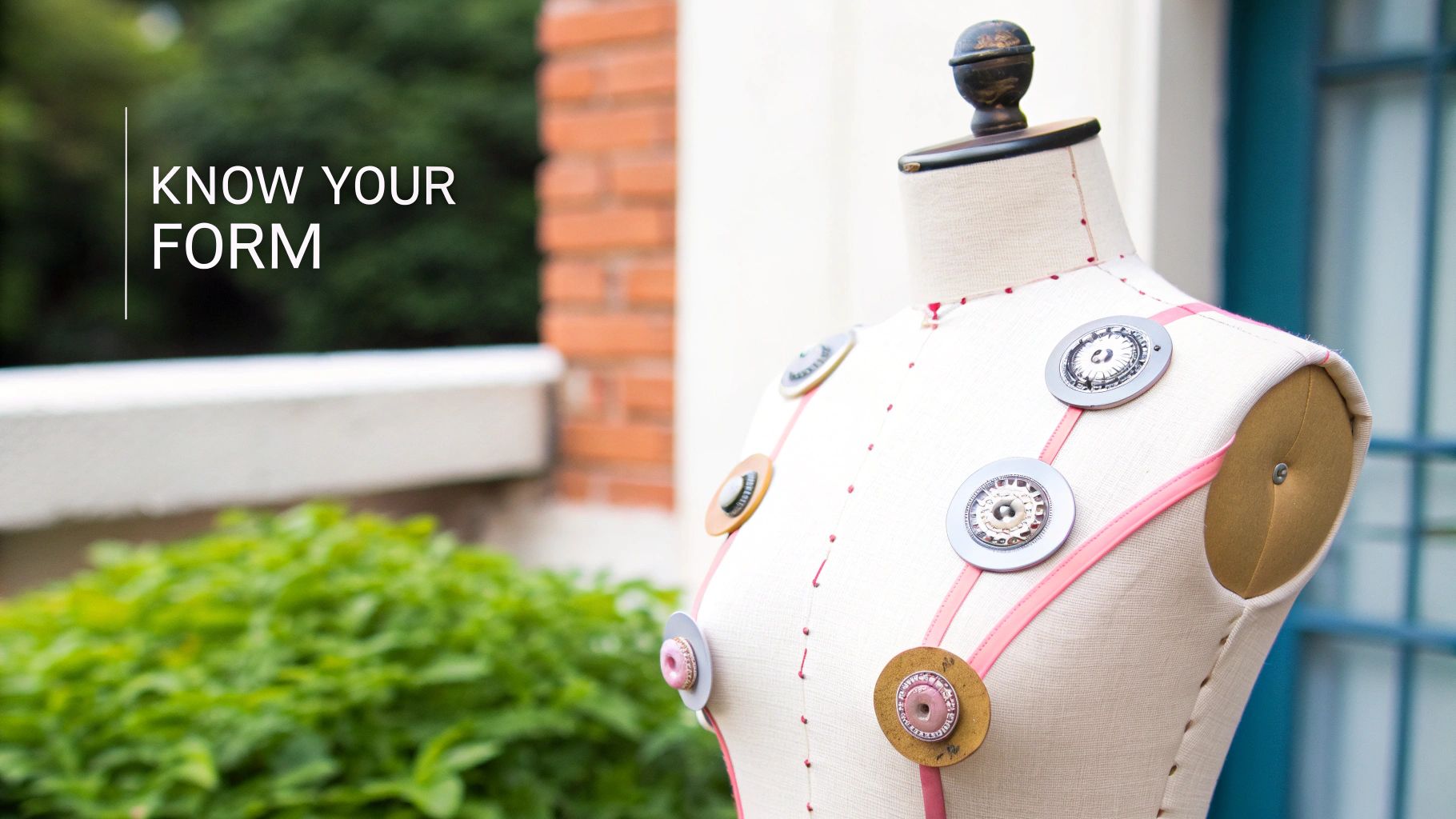
Let's break down the form's anatomy. By seeing how all the pieces fit together, you’ll be able to make smarter adjustments, which is the secret to creating garments with a truly professional fit and finish.
To help you get familiar with the different parts, here's a quick look at the core components and why they are so important for dressmaking.
Key Features of an Adjustable Dressmakers Form
This table breaks down the common components to help you understand what to look for when choosing a form for your sewing projects.
| Feature | What It Does | Why It Matters for Sewing |
|---|---|---|
| Adjustment Dials | Expands and contracts the form's key measurement points (bust, waist, hips). | Allows you to create a precise body double, essential for custom-fitting, tailoring, and pattern adjustments. |
| Pinnable Surface | A foam-backed fabric cover that allows you to push pins directly into the form. | Crucial for draping fabric to create new designs and for pinning garments in place during fittings and alterations. |
| Sturdy Stand | Provides a stable base for the form, often with height adjustment. | Prevents wobbling, supports the weight of heavy garments (like coats or gowns), and lets you work at a comfortable height. |
| Hem Marker | A guide that slides up and down the stand's pole to mark an even hemline. | Saves time and ensures your hems are perfectly level, which can be tricky to do on your own. |
| Adjustable Neck | Allows for fine-tuning of the neck and shoulder area. | Helps you achieve a better fit around the collar and neckline for shirts, blouses, and dresses. |
| Sectioned Body | The torso is split into multiple panels (usually 8 or 12). | Enables independent adjustment of different body areas, offering a more nuanced and accurate shape. |
| Height Adjustment | The central pole can be raised or lowered. | Lets you set the form to the correct back-waist length and work on different parts of a garment without straining. |
Each of these features plays a role in turning a simple dummy into an indispensable sewing partner.
The Heart of Adjustability: The Dials
The real magic of an adjustable dress form lies in its system of dials or keys. These are the controls that let you accurately expand or contract the form at all the critical measurement points. You’ll usually find between 8 and 12 dials placed across the bust, waist, and hips.
When you turn these dials, you’re moving internal plates that either push the sections of the form apart or pull them together, changing the circumference. This clever mechanism is what makes one dummy so versatile, allowing it to mimic countless different body shapes and sizes. It’s this responsive system that makes the tool so powerful for custom tailoring.
A Surface Built for Creativity
The body of the form is more than just a torso—it's your canvas. Good quality forms are covered in a foam-backed fabric, typically nylon or linen, chosen for its grip and durability. This creates a pinnable surface, and that’s non-negotiable for serious sewing.
A pinnable surface is essential for two key creative tasks:
- Draping: This is the art of designing in 3D by pinning and shaping fabric directly onto the form. A surface that grips the material lets you sculpt, experiment, and bring ideas to life.
- Fitting: When you’re altering a garment, you need to pin seams, darts, and tucks to see how the changes will look. Being able to pin straight into the form makes this process fast, easy, and accurate.
Without this feature, the form is just a display mannequin. Its pinnable nature is what turns it into an active partner in your design work.
The Foundation: A Sturdy Stand
Just as a building needs a solid foundation, your dress form needs a stable stand. It has to support the weight of the form itself plus any heavy garments you might be working on, like a wool coat or an elaborate wedding dress. A wobbly stand is not just frustrating; it can throw off your work.
Most stands come in two main styles:
- Tripod Base: This classic three-legged design is incredibly stable because it distributes weight so effectively. It’s a reliable choice if your form will mostly stay in one spot.
- Caster Wheel Base: This type has wheels, making it easy to move the form around your workspace. It's a great option for larger rooms or busy professional studios.
No matter the style, make sure the stand is height-adjustable. This is a crucial ergonomic feature that lets you set the form at a comfortable height, whether you’re pinning a hem down low or working on a collar up high.
A well-designed stand ensures that your focus remains on the garment, not on trying to keep the form from wobbling. It provides the security needed for precise, professional-level work.
Essential Finishing Touches
Beyond the main components, a few smaller features can make a big difference. A built-in hem marker—often a simple pin guide that slides up and down the main pole—is a surprisingly useful tool for getting perfectly level hems every time.
Likewise, an adjustable neck gives you more control for fine-tuning the fit around the collarbone and neckline, which is critical for blouses and dresses. For a deeper dive into getting your measurements just right, you can learn more about how to take and apply mannequin measurements in our detailed guide. All these little elements work together to turn a simple dummy into a sophisticated tool for achieving that perfect fit.
How to Choose the Right Adjustable Form
Picking out an adjustable dressmaker's form is one of the biggest—and best—investments you'll make in your sewing. This isn't just about buying another tool; it’s about finding a reliable partner that acts as your body double. The right choice can transform your fitting process from a struggle into a success, while the wrong one is a shortcut to pure frustration.
The whole decision really starts with a good, honest look at your own sewing habits and what you want to achieve. If you're just starting out and mostly tackling simple dress alterations, your needs will be miles away from a professional designer who’s draping bespoke gowns from scratch. Think of it like buying a kitchen knife: a home cook gets by beautifully with a solid chef's knife, but a sushi master needs a specialised blade for that level of precision.
Matching the Form to Your Sewing Style
First things first: what are you actually going to do with it? For most hobbyists, a simple, user-friendly model with basic dial adjustments is perfect. These forms are brilliant for checking the fit of commercial patterns, handling common alterations, and just getting a feel for how a garment will hang.
Professional designers and dedicated tailors, on the other hand, usually need a bit more firepower. They often look for advanced features that make a real difference in their day-to-day work.
This might include things like:
- Collapsible Shoulders: An absolute lifesaver for getting tight-fitting garments on and off the form without stretching or damaging the neckline.
- Wider Adjustment Ranges: The more a form’s bust, waist, and hip dials can expand, the more versatile it is for working with a variety of client sizes.
- Specialised Attachments: Some pro-level forms come with handy extras like trouser poles or more robust, stable stand options.
Being clear about your main use-case stops you from overspending on features you'll never touch. More importantly, it prevents you from buying a form that simply can't keep up with your creative ambitions.
The Golden Rule of Sizing Your Dress Form
Now for the most critical part of this whole process: sizing. This is, without a doubt, where most people make their biggest mistake. The process seems simple—take your measurements, then find a form with a matching range. Easy, right?
Well, here is the single most important piece of advice you will ever get about buying a dressmaker's form:
If your measurements fall between two sizes, or if a form’s maximum setting is your exact size, always choose the smaller size.
It might feel completely wrong, but trust me, it’s the secret to getting a truly customised fit. You can always add padding to build up a smaller form to your exact dimensions. What you can’t do is make a form that’s too big any smaller. A form that's slightly smaller than you gives you a solid foundation that you can then sculpt into a perfect copy of your unique shape.
Taking Accurate Measurements for a Perfect Match
To get this right, you need a precise set of measurements. Grab a flexible measuring tape and, if you can, a friend to help you get the numbers spot-on. Make sure you’re wearing fitted clothing or the kind of undergarments you'd normally wear with your finished clothes.
Focus on these key areas:
- Full Bust: Measure around the absolute fullest part of your chest, keeping the tape level with the floor.
- Waist: Find your natural waistline—it's usually the narrowest part of your torso—and measure around it.
- Hips: Wrap the tape around the fullest part of your hips and bottom.
- Back Waist Length: This one’s tricky alone. Measure from that prominent bone at the base of your neck straight down to your natural waistline.
With these numbers in hand, you can start comparing them to the size charts from the manufacturer. Remember the goal: find a dressmakers form adjustable range where your measurements fall comfortably somewhere in the middle, not pushed right up to the maximum limit. For a deeper dive, our complete guide on various dress forms for sewing offers more insight into different styles and their unique benefits.
Why Padding Out Is the Professional Standard
Here’s a little industry secret: choosing a smaller form and padding it out isn't a compromise; it's what the pros do. Standard adjustable forms are built on an idealised, perfectly symmetrical figure. But real bodies are anything but. We all have unique curves, postures, and proportions—a slight sway back, one hip that sits a little higher, or a fuller bust.
The dials on a form can only change the circumference. They can't replicate those personal details that make you, you. By starting with a smaller base, you can use foam, wadding, or even pre-made padding kits to build up the form. This is how you sculpt a true body double that mirrors your specific posture and shape, ensuring the clothes you make will fit you—and only you—perfectly. It’s a small extra step that turns a generic tool into your own bespoke fitting instrument.
Setting Up and Customising Your Dress Form
So, you’ve unboxed your new dress form. That’s the easy part. The real work—and where the magic truly begins—is turning that generic mannequin shape into a perfect replica of an actual body. This is where you go beyond the dials and transform it into a genuine sewing partner.
The process is a blend of simple mechanics and a bit of artistry. It starts with assembly, but the real secret to a bespoke fit lies in how you adjust and, most importantly, pad the form. Get these steps right, and your dressmakers form adjustable will become your most valuable tool.
Initial Assembly and First Adjustments
Most dress forms arrive in a few main parts: the torso, the pole, and the stand. Putting them together is usually quite intuitive, but my first piece of advice is always the same: make sure that stand is rock solid. Tighten everything properly from the get-go to avoid any annoying wobbles later on. A steady base is non-negotiable for accurate work.
With the form assembled, the very first measurement to tackle is the height. Adjust the pole until the form’s waistline sits at the same height as the back-waist length of the person you're fitting for. This is your foundation. Get this vertical alignment right before you even think about touching the circumference dials.
Once the height is set, it's time for the dials. The key here is to work methodically to keep the form's proportions symmetrical.
- Bust: Begin with the bust dials, turning them slowly and evenly until you hit your target measurement.
- Waist: Next, move down to the waist, again adjusting each dial a little at a time to expand the form without distorting it.
- Hips: Finally, do the same for the hip dials to set the basic circumferences.
This infographic gives a great overview of the whole process—from measuring and adjusting to the crucial final step of padding.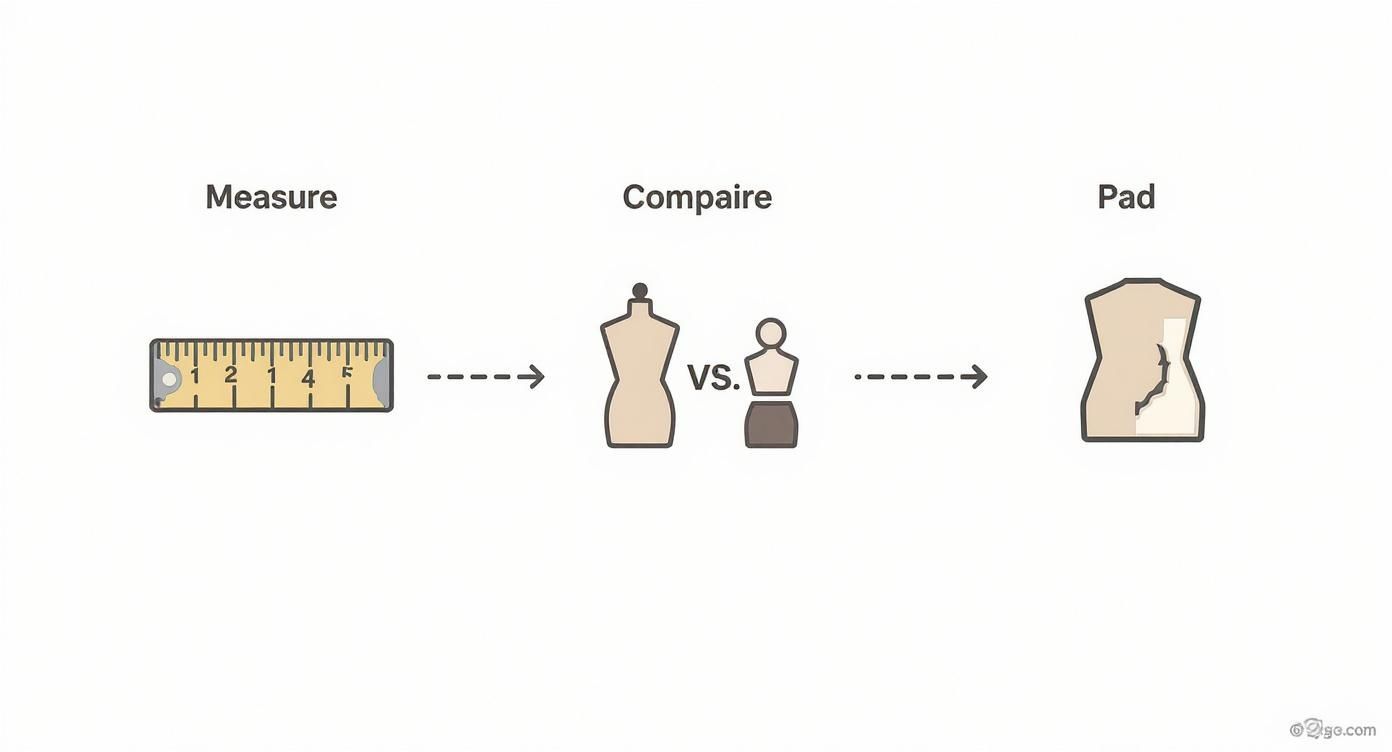
As the graphic shows, creating a true body double isn't just about the dials. It's a three-stage process, and that final padding stage is what really makes the difference.
The Art of Strategic Padding
Here’s a reality check: the adjustment dials are great for hitting basic circumference numbers, but they can’t replicate the unique curves and contours of a real person. That's where padding comes in. This is how we account for the beautiful asymmetries, postures, and shapes that make every body unique.
Padding isn’t just a quick fix. It’s the professional standard for creating a genuine body double. It’s how you build up a fuller bust, accommodate rounded shoulders, or mimic the curve of a sway back.
To get started, you don't need much. Simple polyester batting—the kind you find in quilts—is brilliant for adding soft volume. For more targeted shaping, some dense foam or a few old shoulder pads work wonders.
I find it best to start by putting a snug-fitting t-shirt or a custom-made cover over the form; this gives you a great base to hold the padding in place. From there, you can begin adding layers of batting where they're needed, constantly checking against your measurements. If you want to dive deeper, our guide to the dressmaking dummy adjustable has even more tips for sculpting the perfect shape.
Replicating Unique Body Shapes
Padding is what allows you to capture the subtle details that separate a good fit from an absolutely perfect one. You’re moving beyond simple numbers and into true anatomical accuracy.
- For a Full Bust: The dials tend to create a very generic, high-and-round shape. To create a more natural bust apex, add padding underneath the form’s bustline.
- For a Sway Back: This is a really common posture. You can replicate it by adding padding to the upper back and across the fullest part of the bottom, which creates that characteristic curve in the small of the back.
- For Asymmetrical Hips or Shoulders: It's rare for a body to be perfectly symmetrical. If one hip or shoulder sits higher, simply build up the lower side on the form with foam until it matches the body's natural stance.
Once you’re happy with the shape, the final pro touch is to create a smooth, final cover to go over all the padding. This gives you a seamless, pinnable surface and ensures fabric drapes just as it should, without catching on anything underneath. With these customisations done, your dress form is no longer just a tool—it's your client's exact double, ready to help you craft garments that fit flawlessly.
Putting Your Dress Form to Creative Use
An adjustable dressmakers form is so much more than a stand-in for fittings. Think of it as your silent creative partner. Once you’ve dialled in the measurements, it stops being a simple dummy and becomes the foundation for bringing your most ambitious ideas to life in three dimensions.
This is where you move beyond just checking a commercial pattern’s fit. With a form at your side, you can start working like a professional designer, building garments organically and tackling tricky fitting problems without the guesswork.
The Art of Draping New Designs
Draping is the magic of creating a pattern by working directly with fabric on a 3D form. Instead of starting with flat paper, you let the form guide your hands, sculpting the fabric with pins to discover the perfect shape.
This hands-on approach is incredibly freeing. It lets you see exactly how a certain fabric will hang and move in real-time, making it a far more intuitive way to dream up new styles. You can experiment with placing pleats, creating a beautiful cowl neckline, or designing a complex asymmetrical piece that would be a nightmare to draft on paper. A dressmakers form adjustable to your target measurements means that whatever you create will fit the intended body right from the start.
Nailing Flawless Alterations
For anyone who does alterations, a dress form is an absolute game-changer. Getting a garment to fit just right often means making small, precise adjustments to the back and sides—areas you simply can’t pin accurately on yourself.
When you put the garment on your customised form, you get a clear, 360-degree view of what needs to be done. You can pin darts, take in seams, and tweak shoulder lines with confidence, seeing the effect of every change instantly. This is especially helpful for bigger jobs like tailoring a jacket or reshaping the bodice of a wedding dress, turning what could be a frustrating process into a controlled and accurate one.
The real value of using a form for alterations is the ability to work on a garment without the person being present. It saves time and ensures a professional outcome, especially when dealing with multiple fittings.
Beyond Garment Construction
The uses for an adjustable form don't stop at dressmaking. It proves its worth in all sorts of creative and practical ways, quickly becoming one of the most versatile tools in any studio.
-
Showcasing Finished Work: A dress form makes a fantastic model for your finished pieces. After perfecting your creations, you'll want to take professional product photos to show them off. Using a form gives your garments a consistent and professional look for your online shop or portfolio.
-
Costume and Cosplay Construction: Building structured costumes often means working with unusual materials like foam, thermoplastics, or heavy fabrics. An adjustable form gives you the stable base you need to sculpt armour, build corsetry, or attach fiddly details, all while ensuring the final piece fits the performer perfectly.
-
Checking the Drape of Knits: If you're a knitter or crocheter, a dress form is brilliant for checking the fit and drape of a sweater or cardigan as you go. You can slip your work-in-progress onto the form to see how the weight of the yarn is affecting the shape, preventing the finished garment from being too long or distorted.
Your adjustable form is a powerful and multi-talented tool. By exploring all the different ways you can use it, you'll unlock its full potential and make it a true cornerstone of your creative work.
Keeping Your Adjustable Sewing Form in Top Shape
Think of your dress form as a trusted partner in your sewing journey. Just like any good tool, a little bit of care goes a long way, ensuring it stays accurate and reliable for years and countless projects to come.
Keeping it looking sharp is simple. After a sewing session, a quick once-over with a lint roller will pick up any stray threads and dust. If you spot a small mark, you can gently dab it with a damp cloth and a touch of mild soap. Just be careful not to soak the fabric, as too much moisture could seep into the foam underneath.
Mind the Mechanisms
The real heart of your adjustable form is the internal dials and gears. These are the bits that need the most respect. When you're changing measurements, always turn the dials slowly and smoothly. Trying to force a dial that feels a bit stiff is the quickest way to strip the internal threads, and that's often a permanent problem.
If a dial does get stuck, don't muscle through it. The trick is to slightly turn the other dials on that same level to ease the overall tension. You'll usually find the stuck one frees up immediately. It's a classic case of patience saving you a major headache down the line.
Proper care isn't about grand gestures; it's about mindful use. Treating the adjustment system with a gentle hand is the most important thing you can do to give your form a long and happy life.
The stand needs a bit of attention too. Give the screws and fittings a check every now and then, especially if you wheel your form around your studio a lot. A wobbly base can be frustrating, but it's usually an easy fix. We have a whole guide on how to troubleshoot and maintain the dress form stand if you ever need it.
Finally, where you keep your form matters. Try to store it out of direct sunlight, as the UV rays can fade the cover and make the fabric brittle over time. It's also best to avoid damp areas like a basement or garage, as humidity isn't great for the metal parts or the fabric. Simple habits like these will keep your dress form in prime condition.
Got Questions About Dress Forms? Let's Unpack Them.
Jumping into the world of dress forms can feel a little daunting, and it's natural to have a few questions. We get asked a lot about the nitty-gritty details, so let's clear up some of the most common queries to help you find the right fit for your sewing space.
Whether you're making your first purchase or just looking to get more out of the dummy you already own, a little expert insight goes a long way.
Sizing Dilemmas and Solutions
One of the biggest head-scratchers is what to do when your measurements land squarely between two sizes.
The golden rule here is simple: always go for the smaller size. It sounds backward, I know, but you can’t shrink a form that’s too big. Starting with a slightly smaller base gives you the freedom to pad it out to perfectly match your unique curves. You can't take away, but you can always add! Getting those initial measurements spot-on is your first step to success, and our guide on how to take body measurements for clothes will walk you through it.
Can I Pin Into Any Adjustable Form?
This is a crucial one. The answer is, it depends on the type of pinning you need to do. Most adjustable forms have a hard plastic body with a thin foam layer on top. This setup works perfectly well for slanted pinning—where you slide the pin in at an angle. For many projects, that’s all you’ll ever need.
But if you’re a serious draper or pattern maker, you'll probably want a fully pinnable form. These are built differently, usually with a softer core like dense polystyrene, letting you push pins straight in, deep and secure. If this is a deal-breaker for you, make sure you check the product details for that specific feature.
A truly pinnable surface transforms your dress form from a simple fitting tool into a dynamic canvas for 3D design and pattern creation.
Replicating Unique Posture and Shape
So, what about those unique body quirks, like a sway back or rounded shoulders? The dials are fantastic for adjusting general circumferences, but they can't replicate the subtle contours of a real person's posture.
This is where your inner sculptor comes out to play with custom padding.
- For a sway back: You’ll want to add padding to the upper back and across the fullest part of the hips and bottom. This technique effectively carves out that distinct curve in the lower back.
- For a fuller bust: The dials might create a generally round shape, but padding helps you build up the bust to a more natural apex.
Using foam, cotton batting, or even old shoulder pads, you can build up the form to mirror a specific body precisely. Once you're happy, a custom-fitted cover pulled over the top will smooth everything out and hold it all securely in place, giving you a professional and accurate working surface.
At Display Guru, we have a fantastic range of adjustable and pinnable dress forms ready to meet any creative challenge. Find the perfect partner for your sewing studio by exploring our collection today at https://www.displayguru.co.uk.
